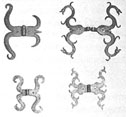A Surprisingly Interesting History of Hinges
The hinge is an incredibly simple yet important piece of technology. Many, including myself, believe the hinge to be one of the greatest inventions of the ancient and modern world. Its importance to everyday life is right up there with the wheel. The actual beginning of the hinge is unknown, but the first traces of the hinge date back to 1600 B.C.
Discoveries in Hattusa, an ancient eastern capital, showed early forms of hinges being used to make massive objects mobile. Hattusa was surrounded by stone walls with two giant wooden doors swinging open on pivots set inside large stone sockets. Sadly, at this date hinges were not available to the average home owners. They were known only to be on public or sacred buildings (sound familiar?). In the Old Testament hinges are mentioned when describing King Solomon’s elaborate temple, which included gold-plated sockets for solid gold doors.
The Egyptians are also included in the history of the hinge. Hinges have been found among Egyptian ruins dating back to about 760-650 B.C. Babylonians and Assyrians, in late B.C. and early A.D., were also recognized as hinge users. Moving slightly forward in time, the hinge begins to develop.
The Romans, being at the forefront in technology, developed an improved hinge system. Not only using the hinge for great community structures, but also for ordinary household items such as cabinets, doors, drawers etc. They had hinges placed on certain armor pieces for greater mobility. The Romans even had a "goddess" of the door hinge known as Cardea.
The next significant advancement in the hinge saga came from the English colonies in the 16th and 17th century. All types of reinforced metals were used to create a stronger and more powerful hinge. Different styles began to develop to make everyday appliances easier to operate. Years later, the American colonists took the idea of the hinge with them. Jamestown settlers imported hinges from English colonies for many of years. Blacksmithing became a very popular job due to the domestic need for hardware for the American colonies.
When colonists eventually moved west, the hinge followed. In the 1850’s Charles Hager founded the present day Hager Hardware company which developed wagon wheel rims and hinges for the wagon doors. By this time, colonists had what is now considered to be a modern day hinge. Since then many innovations of the hinge have developed: the T-hinge in 1843, the ball bearing hinge in 1899, and in 1900 the most common hinge used today was developed, the butt hinge. Today, there are a dizzying number of types and variations of hinges. We hope this site will help you sort them out.





